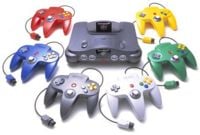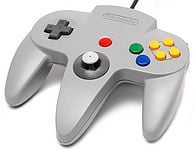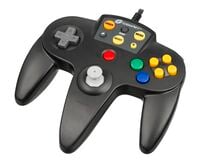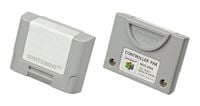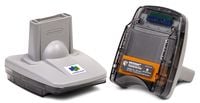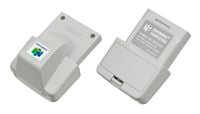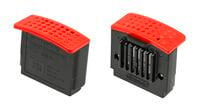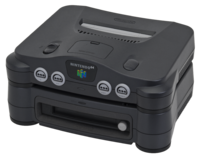Nintendo 64: Difference between revisions
Kirby kart (talk | contribs) (→Trivia) |
m (Text replacement - "{{[Cc]onsoles}}" to "{{Systems}}") |
||
| (244 intermediate revisions by 96 users not shown) | |||
| Line 1: | Line 1: | ||
{{ | {{about|the Nintendo console|the treasure from [[Wario World]]|[[Wonky Circus#Treasures|Wonky Circus § Treasures]]|the sixty-fourth online Nintendo level in [[Mario vs. Donkey Kong: Tipping Stars]]|[[List of official Mario vs. Donkey Kong: Tipping Stars online levels#Nintendo 64|List of official Mario vs. Donkey Kong: Tipping Stars online levels § Nintendo 64]]}} | ||
{{ | {{system infobox | ||
| | |image=[[File:N64 Console.png|250px]] | ||
| | |generation=Fifth | ||
| | |release={{release|Japan|June 23, 1996|USA|September 29, 1996|Australia|March 1, 1997|Europe|March 1, 1997|South Korea|July 19, 1997<ref>[http://www.hardcoregaming101.net/korea/appendix-consoles.htm Hardcore Gaming 101]</ref>|Brazil|December 10, 1997|China|November 17, 2003 (iQue Player)}} | ||
| | |discontinued={{release|Japan|April 30, 2002|Australia|May 11, 2003|Europe|May 16, 2003|USA|November 30, 2003|China|December 31, 2016 (iQue Player)}} | ||
| | |predecessor=[[Super Nintendo Entertainment System]] | ||
|successor=[[Nintendo GameCube]] | |||
}} | }} | ||
{{ | {{quote2|Get N or get out!|The N64 slogan}} | ||
[[File:N64 Logo.svg|left|125px]] | [[File:N64 Logo.svg|left|125px]] | ||
The '''Nintendo 64''' is a video game console created by [[Nintendo]]. It was released in 1996 to compete with the | The '''{{wp|Nintendo 64}}''' (formatted on the logo as '''NINTENDO<sub>®</sub><sup>64</sup>'''), also referred to as the '''N64''', as well as rebranded as the '''{{wp|SK Hynix|Hyundai}} Comboy 64''' in South Korea, is a video game console created by [[Nintendo]]. It was released in 1996 to compete with the {{wp|Sega Saturn}} and the {{wp|PlayStation (console)|PlayStation}}. It was codenamed "Project Reality" during development and is the first Nintendo home console to use the same name and design between the Japanese and international versions. | ||
After failing to beat the PlayStation and the [[Super Nintendo Entertainment System]]'s sales, the Nintendo 64 was described as "a step backwards for the company in terms of commercial success"<ref>https://www.goliath.com/gaming/10-reasons-why-the-nintendo-gamecube-failed/</ref> due to a number of poor business decisions associated with the system, most notably the choice to use ROM cartridges for its games (instead of the higher-capacity CD-ROMs used by competing systems) and a lack of substantial third-party support, the latter of which is commonly pinned on frustrations with Nintendo's licensing policies. Despite this, the Nintendo 64 gained popularity during the first few months of its release, mainly due to the release of the critically acclaimed ''[[Super Mario 64]]''. Furthermore, although its sales figures were lackluster, the Nintendo 64 is not considered a true commercial failure, still generating a profit for Nintendo and outselling the Sega Saturn outside Japan. | |||
''Super Mario 64'' was one of the first games of its kind to feature full 3D graphics and depth of field effects. The Nintendo 64 was able to pull this off because it was the first system to feature a 64-bit processor and 32-bit graphics chip (aside from the failed {{wp|Atari Jaguar}}, which featured multiple coprocessors using 64-bit architecture on a 32-bit main processor). The Nintendo 64 also featured the first successful analog control stick implementation and four built-in controller ports, unlike its competitors, the PlayStation and the Sega Saturn. The console is also Nintendo's first with 16:9 widescreen support (in addition to the traditional 4:3), though only 13 titles supported this feature, with ''[[Donkey Kong 64]]'' being the sole game related to the [[Super Mario (franchise)|''Super Mario'' franchise]] among them. Conversely, the Nintendo 64 is noted as the last home console system to use cartridges until the [[Nintendo Switch]]. Starting with the [[Nintendo GameCube]] and carrying on until the [[Wii U]], Nintendo would shift to using optical discs like its competitors, albeit with proprietary formats instead of industry standard ones. | |||
The Nintendo 64 is best known for games such as ''Super Mario 64'', ''[[Super Smash Bros.]]'', ''[[Mario Kart 64]]'', ''[[Mario Party]]'', ''[[Paper Mario]]'', ''[[Donkey Kong 64]]'', ''[[lylatwiki:Star Fox 64|Star Fox 64]]'', ''[[zeldawiki:The Legend of Zelda: Ocarina of Time|The Legend of Zelda: Ocarina of Time]]'', ''{{wp|GoldenEye 007 (1997 video game)|GoldenEye 007}}'', ''{{wp|Banjo-Kazooie (video game)|Banjo-Kazooie}}'', and ''[[fzerowiki:F-Zero X|F-Zero X]]''. Production of the Nintendo 64 ended in 2002. The Nintendo 64 sold 32.93 million units during its lifetime.<ref>December 31, 2020. [https://www.nintendo.co.jp/ir/en/finance/hard_soft/ Dedicated Video Game Sales Units]. ''Nintendo''. Retrieved March 31, 2021.</ref> | |||
[[ | In 1999, Nintendo released the [[Nintendo 64DD]]; similarly to the [[Family Computer Disk System]], it was an add-on that enabled support for games on proprietary magnetic disks. The add-on was intended as a cheaper alternative to optical disc-based competitors, but it ultimately became a commercial failure due to its belated and limited release. In total, four games of the ''Super Mario'' franchise were released on the 64DD, all in the ''[[Mario Artist (series)|Mario Artist]]'' series. | ||
In 2003, the '''[[nwiki:iQue Player|iQue Player]]''' was released in China, serving as the Chinese equivalent of the Nintendo 64, albeit with a differently designed controller. Its D-Pad and analog stick are placed as on the Nintendo GameCube Controller. The entire system consists of only the controller, which has the chip onboard. It has a limited selection of ''Super Mario'' titles, all of which were released for the Nintendo 64 outside China. These include ''Super Mario 64'', ''Mario Kart 64'', ''Paper Mario'', ''[[Yoshi's Story]]'', ''[[Dr. Mario 64]]'', and ''Super Smash Bros.'' | |||
[[ | |||
The | |||
==Accessories== | |||
===Nintendo 64 Controller=== | |||
[[File:N64system.jpg|thumb|left|The original Nintendo 64 and six controller colors]] | |||
[[File:Nintendo Sixty Four Controller.jpg|thumb|x150px|The Nintendo 64 Controller, the standard controller for playing Nintendo 64 games]] | |||
[[File:LodgeNet-Nintendo-N64-Controller.jpg|thumb|LodgeNet Nintendo 64 Controller]] | |||
The '''Nintendo 64 Controller''' is the standard controller for the Nintendo 64. It is unique among video game controllers, as it has three grips instead of the more common two, resembling the letter ''M''. There are many color variations of the controller, including solid and clear colors. This was a unique concept at the time. | |||
===Buttons=== | The Nintendo 64 is not the first console to use analog control sticks; it is just the first successful console to use them. The {{wp|Vectrex}} was the first home console to have an analog stick; it also had four controller ports, a feature that was not popularized until the Nintendo 64. | ||
The Nintendo 64 | |||
*A | There was also a [[LodgeNet]] controller that was exclusive to hotels.<ref name="Nintendrew">Nintendrew (August 15, 2018). [https://www.youtube.com/watch?v=HK_EPiRkFew&ab_channel=Nintendrew LodgeNet Game Controllers - Nintendo's Hotel Rental Service! | Nintendrew]. ''YouTube''.</ref> | ||
*B | {{br|left}} | ||
====Buttons==== | |||
The Nintendo 64 Controller lost the {{button|snes|X}}, {{button|snes|Y}}, and {{button|snes|Select}} buttons from the [[Super Nintendo Entertainment System|SNES]] but instead features additional buttons: | |||
*A {{button|n64|A}} | |||
*B {{button|n64|B}} | |||
*Camera Buttons/C Buttons {{button|n64|c}} * | *Camera Buttons/C Buttons {{button|n64|c}} * | ||
**Camera Up/C-Up | **Camera Up/C-Up {{button|n64|Cup}} * | ||
**Camera Right/C-Right | **Camera Right/C-Right {{button|n64|Cright}} * | ||
**Camera Down/C-Down | **Camera Down/C-Down {{button|n64|Cdown}} * | ||
**Camera Left/C-Left | **Camera Left/C-Left {{button|n64|Cleft}} * | ||
*START | *START {{button|n64|Start}} | ||
*Z Trigger | *Z Trigger {{button|n64|Z}} * | ||
* | *L Trigger {{button|n64|L}} | ||
* | *R Trigger {{button|n64|R}} | ||
*Control Stick | *Control Stick {{button|n64|Stick}} * | ||
*Control Pad | *Control Pad {{button|Pad}} | ||
<small><nowiki>*</nowiki> – Signifies new buttons</small> | |||
== | ===Controller Pak=== | ||
[[File:N64 Controller Pak.jpg|thumb|left|Controller Pak]] | |||
Although this item was not required like for the Nintendo 64's competitor, the {{wp|PlayStation (console)|PlayStation}}, some games utilized external storage by the use of the '''[[Memory Card#Nintendo 64|Controller Pak]]''', such as ''Mario Kart 64'', which can save [[Ghost (Mario Kart series)|ghost]]s for Time Trials. | |||
{{br}} | |||
===Transfer Pak=== | |||
{{main|Transfer Pak}} | |||
[[File:Gbc transfer pak en.jpg|thumb|Transfer Pak]] | |||
The '''Transfer Pak''' allows [[Game Boy]] and [[Game Boy Color]] games to connect to select Nintendo 64 games. It was bundled with ''[[Bulbapedia:Pokémon Stadium (English)|Pokémon Stadium]]'', although [[Mario Golf (Nintendo 64)|''Mario Golf'' (Nintendo 64)]] and [[Mario Tennis (Nintendo 64)|''Mario Tennis'' (Nintendo 64)]] can connect with [[Mario Golf (Game Boy Color)|''Mario Golf'' (Game Boy Color)]] and [[Mario Tennis (Game Boy Color)|''Mario Tennis'' (Game Boy Color)]], respectively. The [[Game Boy Camera]] is the only Game Boy game to connect with a [[Nintendo 64DD]] game: ''[[Mario Artist: Paint Studio]]''. | |||
{{br}} | |||
== | ===Rumble Pak=== | ||
''<gallery> | {{main-external|NWiki|Rumble (feature)#Nintendo 64|NintendoWiki}} | ||
[[File:RumblePak64.jpg|thumb|left|Rumble Pak]] | |||
[[File:MarioRumblePak.png|thumb|Promotional artwork of [[Mario]] to showcase the Nintendo 64 Rumble Pak, and how it is inserted into the controller]] | |||
Bundled with ''[[LylatWiki:Star Fox 64|Star Fox 64]]'', the '''Rumble Pak''' is an accessory inserted into the controller's memory cartridge slot, although this prevents simultaneous use of the Controller Pak. The Rumble Pak made the Nintendo 64 the first home console to utilize {{wp|Haptic technology|force-feedback vibration}} and has since become standard in gaming. Almost all ''Super Mario'' games include it as a feature. ''[[Super Mario 64]]'' initially did not have Rumble Pak support, but later a Rumble Pak-supported version named ''Super Mario 64: Shindō Pak Taiō Version'' was released. | |||
{{br}} | |||
===Expansion Pak=== | |||
{{main-external|NWiki|Expansion Pak|NintendoWiki}} | |||
[[File:The Expansion Pak.jpg|thumb|The Expansion Pak]] | |||
The '''Expansion Pak''' is a RAM expansion that adds four additional megabytes of RAM to the console while in use, increasing the total amount of RAM accessible to eight megabytes. It is added console by removing the cover marked "Memory Expansion" in front of the cartridge slot and inserting it into the slot underneath, replacing the system's pre-installed Jumper Pak. | |||
One ''[[Super Mario (franchise)|Super Mario]]''-related game requires the use of the Expansion Pak, ''[[Donkey Kong 64]]'', and because of to this, a free Expansion Pak was bundled with earlier copies of the game. A [[List of rumors and urban legends#Donkey Kong 64 only required the Expansion Pak to fix a memory leak|rumor]] states that ''Donkey Kong 64'' required the Expansion Pak as the result of a memory leak or game-breaking bug, reinforced by a video created by former [[Rare Ltd.|Rare]] employee Chris Marlow. However, this has been denied by ''Donkey Kong 64'' developer [[Mark Stevenson]], who suggested that the rumor was a byproduct of the conflation of two separate stories involving the Expansion Pak and a severe bug, respectively. | |||
===Nintendo 64DD=== | |||
{{main|Nintendo 64DD}} | |||
[[File:64DD Console.png|thumb|left|The Nintendo 64DD attached to a Nintendo 64]] | |||
The '''Nintendo 64DD''' accessory was commercially available only in Japan and was a failure, although it was planned for an international release. Only four ''Super Mario'' games were released for it, all of them being part of the ''[[Mario Artist (series)|Mario Artist]]'' series. | |||
{{br}} | |||
==''Super Mario'' appearances== | |||
*In ''[[Donkey Kong Country 3: Dixie Kong's Double Trouble!]]'', there is a chance that [[Wrinkly Kong]] plays on a Nintendo 64 in [[Wrinkly's Save Cave]]. | |||
*In ''[[Yoshi's Story]]'', a Nintendo 64 can be seen in the backgrounds of a few [[level]]s. | |||
*In ''[[Super Smash Bros. Melee]]'' in the background of the stand where all of the player's [[Trophy (Super Smash Bros. series)|trophies]] are, a Nintendo 64 with the controller and the ''[[Super Smash Bros.]]'' game cartridge and box appear on a shelf, along with various other Nintendo systems. | |||
*In ''[[Wario World]]'', a Nintendo 64 appears as a [[List of treasures in Wario World|treasure]]. | |||
*In ''[[Super Paper Mario]]'', in one of [[Francis]]'s rooms, a Nintendo 64 can be seen alongside the other Nintendo platforms released by that time, as well as a [[Virtual Boy]]. | |||
*In ''[[Super Smash Bros. Brawl]]'', one of the names that can appear whenever a player presses the random button when they are naming their custom stage is "N64." | |||
*In ''[[WarioWare Gold]]'', the Nintendo 64 appears as a collectible Nintendo [[List of souvenirs in WarioWare Gold|souvenir]]. | |||
*In ''[[Super Smash Bros. Ultimate]]'', there was a [[Super Smash Bros. Ultimate#Spirit Board|Spirit Board]] [[smashwiki:Get N or Get Out|event]] focused on spirits from the Nintendo 64 era. The name of the event was the slogan of the Nintendo 64. | |||
*In ''[[WarioWare: Get It Together!]]'' in [[9-Volt]]'s Nintendo Classics level, the boss that appears in the intermission before the boss microgame wears an upside-down Nintendo 64 Controller as a crown. | |||
*In ''[[The Super Mario Bros. Movie]]'', one of the islands surrounding the [[Mushroom Kingdom]] is in the shape of a Nintendo 64 controller with the left grip broken off. | |||
<br> | |||
<gallery> | |||
SSBM HALTV.png|''[[Super Smash Bros. Melee]]'' | |||
SPM Francisroomright.png|''[[Super Paper Mario]]'' | |||
WWGIT Nintendo Classics Boss.jpg|''[[WarioWare: Get It Together!]]'' | |||
TSMBM map.png|''[[The Super Mario Bros. Movie]]'' | |||
</gallery> | |||
==Gallery== | |||
{{main-gallery}} | |||
<gallery> | |||
Diddysracing.jpg|''[[Diddy Kong Racing]]'' | |||
N64 donkeykong64.jpg|''[[Donkey Kong 64]]'' | |||
DM64 Cover.jpg|''[[Dr. Mario 64]]'' | |||
Mario Golf 64 box.png|''[[Mario Golf (Nintendo 64)|Mario Golf]]'' | |||
MK64 Cover.png|''[[Mario Kart 64]]'' | |||
Mariopictures.jpg|''[[Mario no Photopi]]'' | |||
MP1 Cover.jpg|''[[Mario Party]]'' | |||
Mario Party 2 box art.jpg|''[[Mario Party 2]]'' | |||
Mario Party 3 box art.jpg|''[[Mario Party 3]]'' | |||
Mario Tennis 64 box art.jpg|''[[Mario Tennis (Nintendo 64)|Mario Tennis]]'' | |||
Paper Mario 64 box.png|''[[Paper Mario]]'' | |||
Super Mario 64 Boxart.png|''[[Super Mario 64]]'' | |||
SM64 Japanese Rumble Pak cover.jpg|''[[Super Mario 64|Super Mario 64: Shindō Pak Taiō Version]]'' | |||
Super Smash Bros N64 box.png|''[[Super Smash Bros.]]'' | |||
Yoshi's Story Box.png|''[[Yoshi's Story]]'' | |||
</gallery> | </gallery> | ||
==Trivia== | ==Trivia== | ||
*''Guinness World Records 2011 Gamer's Edition'' states that ''[[Super Mario Bros.]]'' was ported to the Nintendo 64 | *''[[Guinness World Records]] 2011: Gamer's Edition'' falsely states that ''[[Super Mario Bros.]]'' was ported to the Nintendo 64.<ref>Guinness World Records. (2011). ''Guinness World Records 2011: Gamer's Edition''. BradyGames. p. 111.</ref> | ||
*Several Nintendo 64 games depict the cartridges with a different artwork than their corresponding box | *Several Nintendo 64 games depict the cartridges with a different artwork than their corresponding box art (e.g., ''Super Mario 64'', ''Mario Kart 64'', ''Donkey Kong 64'', etc.). | ||
*In Japan, the Nintendo 64 was discontinued before the Super Famicom. | *In Japan, the Nintendo 64 was discontinued before the Famicom and Super Famicom.<ref>Niizumi, Hirohiko. (May 30, 2003). [https://web.archive.org/web/20070930172724/http://www.gamespot.com/news/6029220.html Nintendo to end Famicom and Super Famicom production]. ''GameSpot''. Retrieved December 3, 2022.</ref><ref>Reisinger, Don. (June 23, 2016). [https://fortune.com/2016/06/23/nintendo-64-20-years-old/ That Was Quick: Nintendo 64 Is 20 Years Old]. ''Fortune''. Retrieved December 3, 2022.</ref> | ||
*''Super Mario 64'' | *''Super Mario 64'' helped to define the layout of the N64 Controller: the Control Stick {{button|n64|Stick}} and {{button|n64|c}} buttons respectively being incorporated for better movement in a 3D environment and better free-camera control.<ref>DidYouKnowGaming? (September 29, 2012). [http://www.youtube.com/watch?v=glC3zXaJjtQ Mario - Did You Know Gaming? Feat. Egoraptor]. ''YouTube''.</ref> | ||
* | *The Nintendo 64 was Nintendo's last system to be distributed by {{wp|SK Hynix|Hyundai Electronics}} in South Korea. Later systems would be distributed in the region by Nintendo themselves, owed to South Korea lifting most of its bans on Japanese cultural imports between 1998 and 2004. Consequently, it is also Nintendo's last system to go under a different name in an international market, one generation after abandoning the practice in North America and PAL regions. | ||
==References== | ==References== | ||
{{NIWA|Bulbapedia=1|FZeroWiki=1|LylatWiki=1|MetroidWiki=1|NWiki=1|Nookipedia=1|SmashWiki=1|StrategyWiki=Category:Nintendo 64|WiKirby=1|WikiBound=1|ZeldaWiki=1}} | |||
<references/> | <references/> | ||
{{N64}} | {{N64}} | ||
{{Systems}} | |||
[[de:Nintendo 64]] | [[de:Nintendo 64]] | ||
[[it:Nintendo 64]] | [[it:Nintendo 64]] | ||
[[Category:Systems]] | |||
Latest revision as of 17:14, April 20, 2024
- This article is about the Nintendo console. For the treasure from Wario World, see Wonky Circus § Treasures. For the sixty-fourth online Nintendo level in Mario vs. Donkey Kong: Tipping Stars, see List of official Mario vs. Donkey Kong: Tipping Stars online levels § Nintendo 64.
| Nintendo 64 | |
|---|---|
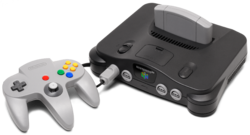
| |
| Generation | Fifth generation |
| Release date | |
| Discontinued | |
| Predecessor | Super Nintendo Entertainment System |
| Successor | Nintendo GameCube |
- “Get N or get out!”
- —The N64 slogan
The Nintendo 64 (formatted on the logo as NINTENDO®64), also referred to as the N64, as well as rebranded as the Hyundai Comboy 64 in South Korea, is a video game console created by Nintendo. It was released in 1996 to compete with the Sega Saturn and the PlayStation. It was codenamed "Project Reality" during development and is the first Nintendo home console to use the same name and design between the Japanese and international versions.
After failing to beat the PlayStation and the Super Nintendo Entertainment System's sales, the Nintendo 64 was described as "a step backwards for the company in terms of commercial success"[2] due to a number of poor business decisions associated with the system, most notably the choice to use ROM cartridges for its games (instead of the higher-capacity CD-ROMs used by competing systems) and a lack of substantial third-party support, the latter of which is commonly pinned on frustrations with Nintendo's licensing policies. Despite this, the Nintendo 64 gained popularity during the first few months of its release, mainly due to the release of the critically acclaimed Super Mario 64. Furthermore, although its sales figures were lackluster, the Nintendo 64 is not considered a true commercial failure, still generating a profit for Nintendo and outselling the Sega Saturn outside Japan.
Super Mario 64 was one of the first games of its kind to feature full 3D graphics and depth of field effects. The Nintendo 64 was able to pull this off because it was the first system to feature a 64-bit processor and 32-bit graphics chip (aside from the failed Atari Jaguar, which featured multiple coprocessors using 64-bit architecture on a 32-bit main processor). The Nintendo 64 also featured the first successful analog control stick implementation and four built-in controller ports, unlike its competitors, the PlayStation and the Sega Saturn. The console is also Nintendo's first with 16:9 widescreen support (in addition to the traditional 4:3), though only 13 titles supported this feature, with Donkey Kong 64 being the sole game related to the Super Mario franchise among them. Conversely, the Nintendo 64 is noted as the last home console system to use cartridges until the Nintendo Switch. Starting with the Nintendo GameCube and carrying on until the Wii U, Nintendo would shift to using optical discs like its competitors, albeit with proprietary formats instead of industry standard ones.
The Nintendo 64 is best known for games such as Super Mario 64, Super Smash Bros., Mario Kart 64, Mario Party, Paper Mario, Donkey Kong 64, Star Fox 64, The Legend of Zelda: Ocarina of Time, GoldenEye 007, Banjo-Kazooie, and F-Zero X. Production of the Nintendo 64 ended in 2002. The Nintendo 64 sold 32.93 million units during its lifetime.[3]
In 1999, Nintendo released the Nintendo 64DD; similarly to the Family Computer Disk System, it was an add-on that enabled support for games on proprietary magnetic disks. The add-on was intended as a cheaper alternative to optical disc-based competitors, but it ultimately became a commercial failure due to its belated and limited release. In total, four games of the Super Mario franchise were released on the 64DD, all in the Mario Artist series.
In 2003, the iQue Player was released in China, serving as the Chinese equivalent of the Nintendo 64, albeit with a differently designed controller. Its D-Pad and analog stick are placed as on the Nintendo GameCube Controller. The entire system consists of only the controller, which has the chip onboard. It has a limited selection of Super Mario titles, all of which were released for the Nintendo 64 outside China. These include Super Mario 64, Mario Kart 64, Paper Mario, Yoshi's Story, Dr. Mario 64, and Super Smash Bros.
Accessories[edit]
Nintendo 64 Controller[edit]
The Nintendo 64 Controller is the standard controller for the Nintendo 64. It is unique among video game controllers, as it has three grips instead of the more common two, resembling the letter M. There are many color variations of the controller, including solid and clear colors. This was a unique concept at the time.
The Nintendo 64 is not the first console to use analog control sticks; it is just the first successful console to use them. The Vectrex was the first home console to have an analog stick; it also had four controller ports, a feature that was not popularized until the Nintendo 64.
There was also a LodgeNet controller that was exclusive to hotels.[4]
Buttons[edit]
The Nintendo 64 Controller lost the ,
, and
buttons from the SNES but instead features additional buttons:
- A

- B

- Camera Buttons/C Buttons
 *
*
- Camera Up/C-Up
 *
* - Camera Right/C-Right
 *
* - Camera Down/C-Down
 *
* - Camera Left/C-Left
 *
*
- Camera Up/C-Up
- START

- Z Trigger
 *
* - L Trigger
- R Trigger
- Control Stick
 *
* - Control Pad
* – Signifies new buttons
Controller Pak[edit]
Although this item was not required like for the Nintendo 64's competitor, the PlayStation, some games utilized external storage by the use of the Controller Pak, such as Mario Kart 64, which can save ghosts for Time Trials.
Transfer Pak[edit]
- Main article: Transfer Pak
The Transfer Pak allows Game Boy and Game Boy Color games to connect to select Nintendo 64 games. It was bundled with Pokémon Stadium, although Mario Golf (Nintendo 64) and Mario Tennis (Nintendo 64) can connect with Mario Golf (Game Boy Color) and Mario Tennis (Game Boy Color), respectively. The Game Boy Camera is the only Game Boy game to connect with a Nintendo 64DD game: Mario Artist: Paint Studio.
Rumble Pak[edit]
- NintendoWiki article: Rumble (feature)#Nintendo 64
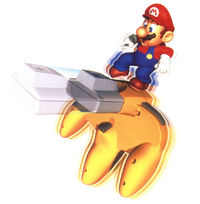
Bundled with Star Fox 64, the Rumble Pak is an accessory inserted into the controller's memory cartridge slot, although this prevents simultaneous use of the Controller Pak. The Rumble Pak made the Nintendo 64 the first home console to utilize force-feedback vibration and has since become standard in gaming. Almost all Super Mario games include it as a feature. Super Mario 64 initially did not have Rumble Pak support, but later a Rumble Pak-supported version named Super Mario 64: Shindō Pak Taiō Version was released.
Expansion Pak[edit]
- NintendoWiki article: Expansion Pak
The Expansion Pak is a RAM expansion that adds four additional megabytes of RAM to the console while in use, increasing the total amount of RAM accessible to eight megabytes. It is added console by removing the cover marked "Memory Expansion" in front of the cartridge slot and inserting it into the slot underneath, replacing the system's pre-installed Jumper Pak.
One Super Mario-related game requires the use of the Expansion Pak, Donkey Kong 64, and because of to this, a free Expansion Pak was bundled with earlier copies of the game. A rumor states that Donkey Kong 64 required the Expansion Pak as the result of a memory leak or game-breaking bug, reinforced by a video created by former Rare employee Chris Marlow. However, this has been denied by Donkey Kong 64 developer Mark Stevenson, who suggested that the rumor was a byproduct of the conflation of two separate stories involving the Expansion Pak and a severe bug, respectively.
Nintendo 64DD[edit]
- Main article: Nintendo 64DD
The Nintendo 64DD accessory was commercially available only in Japan and was a failure, although it was planned for an international release. Only four Super Mario games were released for it, all of them being part of the Mario Artist series.
Super Mario appearances[edit]
- In Donkey Kong Country 3: Dixie Kong's Double Trouble!, there is a chance that Wrinkly Kong plays on a Nintendo 64 in Wrinkly's Save Cave.
- In Yoshi's Story, a Nintendo 64 can be seen in the backgrounds of a few levels.
- In Super Smash Bros. Melee in the background of the stand where all of the player's trophies are, a Nintendo 64 with the controller and the Super Smash Bros. game cartridge and box appear on a shelf, along with various other Nintendo systems.
- In Wario World, a Nintendo 64 appears as a treasure.
- In Super Paper Mario, in one of Francis's rooms, a Nintendo 64 can be seen alongside the other Nintendo platforms released by that time, as well as a Virtual Boy.
- In Super Smash Bros. Brawl, one of the names that can appear whenever a player presses the random button when they are naming their custom stage is "N64."
- In WarioWare Gold, the Nintendo 64 appears as a collectible Nintendo souvenir.
- In Super Smash Bros. Ultimate, there was a Spirit Board event focused on spirits from the Nintendo 64 era. The name of the event was the slogan of the Nintendo 64.
- In WarioWare: Get It Together! in 9-Volt's Nintendo Classics level, the boss that appears in the intermission before the boss microgame wears an upside-down Nintendo 64 Controller as a crown.
- In The Super Mario Bros. Movie, one of the islands surrounding the Mushroom Kingdom is in the shape of a Nintendo 64 controller with the left grip broken off.
Gallery[edit]
- For this subject's image gallery, see Gallery:Nintendo 64.
Trivia[edit]
- Guinness World Records 2011: Gamer's Edition falsely states that Super Mario Bros. was ported to the Nintendo 64.[5]
- Several Nintendo 64 games depict the cartridges with a different artwork than their corresponding box art (e.g., Super Mario 64, Mario Kart 64, Donkey Kong 64, etc.).
- In Japan, the Nintendo 64 was discontinued before the Famicom and Super Famicom.[6][7]
- Super Mario 64 helped to define the layout of the N64 Controller: the Control Stick
 and
and  buttons respectively being incorporated for better movement in a 3D environment and better free-camera control.[8]
buttons respectively being incorporated for better movement in a 3D environment and better free-camera control.[8] - The Nintendo 64 was Nintendo's last system to be distributed by Hyundai Electronics in South Korea. Later systems would be distributed in the region by Nintendo themselves, owed to South Korea lifting most of its bans on Japanese cultural imports between 1998 and 2004. Consequently, it is also Nintendo's last system to go under a different name in an international market, one generation after abandoning the practice in North America and PAL regions.
References[edit]
- ^ Hardcore Gaming 101
- ^ https://www.goliath.com/gaming/10-reasons-why-the-nintendo-gamecube-failed/
- ^ December 31, 2020. Dedicated Video Game Sales Units. Nintendo. Retrieved March 31, 2021.
- ^ Nintendrew (August 15, 2018). LodgeNet Game Controllers - Nintendo's Hotel Rental Service! | Nintendrew. YouTube.
- ^ Guinness World Records. (2011). Guinness World Records 2011: Gamer's Edition. BradyGames. p. 111.
- ^ Niizumi, Hirohiko. (May 30, 2003). Nintendo to end Famicom and Super Famicom production. GameSpot. Retrieved December 3, 2022.
- ^ Reisinger, Don. (June 23, 2016). That Was Quick: Nintendo 64 Is 20 Years Old. Fortune. Retrieved December 3, 2022.
- ^ DidYouKnowGaming? (September 29, 2012). Mario - Did You Know Gaming? Feat. Egoraptor. YouTube.
| Nintendo 64 games | ||
|---|---|---|
| Super Mario franchise | Super Mario 64 (1996) • Mario Kart 64 (1996) • Mario no Photopi (1998) • Mario Party (1998) • Mario Golf (1999) • Mario Artist: Paint Studio* (1999) • Mario Party 2 (1999) • Mario Artist: Talent Studio* (2000) • Mario Artist: Communication Kit* (2000) • Mario Tennis (2000) • Paper Mario (2000) • Mario Artist: Polygon Studio* (2000) • Mario Party 3 (2000) • Dr. Mario 64 (2001) | |
| Donkey Kong franchise | Diddy Kong Racing (1997) • Donkey Kong 64 (1999) | |
| Yoshi franchise | Yoshi's Story (1997) | |
| Crossovers | Super Smash Bros. (1999) | |
| Video game systems and add-ons | |
|---|---|
| Nintendo home consoles | Nintendo Entertainment System/Family Computer (Family BASIC, Family Computer Disk System) • Super Nintendo Entertainment System/Super Famicom (Satellaview, Super Game Boy) • Nintendo 64 (Nintendo 64DD) • Nintendo GameCube (Game Boy Player) • Wii (Virtual Console, WiiWare) • Wii U (Virtual Console) |
| Nintendo handhelds | Game & Watch • Game Boy • Virtual Boy • Game Boy Color • Game Boy Advance • Nintendo DS (Nintendo DSi, DSiWare) • Nintendo 3DS (Virtual Console) |
| Other | MS-DOS • VS. System • Nintendo PlayChoice-10 • Nelsonic Game Watch • Super Mario Bros. Watch • Gamewatch Boy • Philips CD-i • Mini Classics • Nintendo Switch • Triforce • Visteon Dockable Entertainment System • Classics • LodgeNet |

